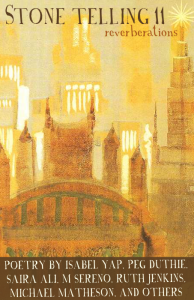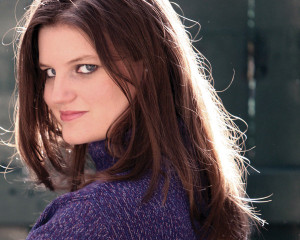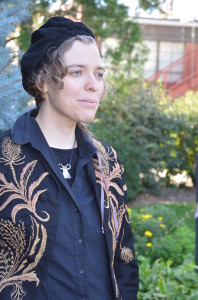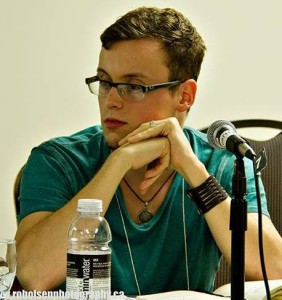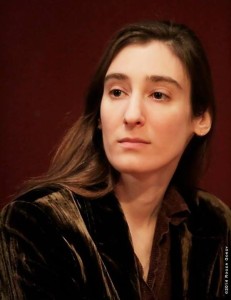Today’s interview features Emily Jiang, who contributed to the Body issue with her poem “Good Enough“. This is Emily’s sixth appearance in the magazine. In addition to poems like “Self-Portrait” and “Merciful Deity“, she also had a nonfiction article, “In Search of Truth and Beauty within the Intersection of Multicultural Myths and Poetry“, that appeared in Issue 5.

Emily Jiang loves speaking with her hands and is happy to teach anyone the ASL signs for “Release the Kraken.” Her poem “Good Enough” holds two truths and a lie. Her less autobiographical poetry can be found in previous issues of Stone Telling, Strange Horizons, and Goblin Fruit and in the forthcoming anthology In Other Words. She is the author of Summoning the Phoenix: Poems & Prose about Chinese Musical Instruments, illustrated by April Chu and published by Shen’s Books, the newest imprint of Lee & Low. Summoning the Phoenix will be available in Spring 2014. Emily also blogs about multicultural children’s literature and other topics at EmilyJiang.com.
My fingers are too small
to span an octave
of the piano,
so I broke the chords
to suit my hands.
– from Good Enough
ST: What inspired this particular poem? What would you like readers to know about your context, and how it relates to your poem?
I wrote “Good Enough” specifically to submit to Stone Telling for its Body Issue. The body focus for the poem is hands, specifically mine. I already had a “Feeling My Feet” poem that focused on reclaiming dancer’s feet, so I thought a poem about musician’s hands would be a nice companion piece.
Ten fingers, ten toes,
Two ears, one nose–just reach out–
touch, hear, smell the rose.
The first lines “My fingers are too thick / for strings / of the violin” was a line that stuck with me since I was sixteen. I was playing a Bach violin-piano duo in the Junior Bach Festival, and the violinist, also sixteen at the time, told me my fingers were too thick to play the violin. And I believed her, for years, until I watched a video of Isaac Perlman playing the violin. The man is a virtuoso, and his fingers are definitely thicker than mine, yet he can make a violin sing so sweetly. He still performs in public, and he’s in his sixties. I love it when artists defy expectations.
He plays with eyes closed,
head tilt to the left, absorbed.
Hear his fingers fly.
I’ve always disliked how my hands looked, and “Good Enough” was a way for me to not only address them, but to celebrate them.
Beauty is not just
in the being. It’s also
in the work-doing.
ST: Is the Body a central theme in your work? If so, what other works of yours deal with it? If not, what called you to it this time?
Body is a theme I’ve thought deeply about for a quite some time. Growing up Asian-American in Texas, I was keenly aware that my body, and therefore my appearance, was foreign and Other to pretty much everyone I met. The visual body is often what we are judged upon the most, yet it does not completely define who we are. As an undergrad, my senior poetry collection was themed on Body and Family. I wrote about hair, pierced ears, more hands/fingers, Buddha belly, and a strawberry tumor.
Strawberry tumors
are benign. Buddha bellies
hold the world’s sorrows.
Currently I’m working on a YA novel about an Asian-American teenager dealing with a sudden growth spurt and weight gain while everyone around her remains petite and un-empathetic. It’s supposed to be funny, but there’s a lot of pain infused in the humor, too.
When my body grows
too big, I’m invisible.
That’s when I can laugh.
ST: What else would you like to tell our readers about your poem?
I must confess reading “Good Enough” aloud was the most difficult recording I’ve had to do. You probably can’t tell, but I kept crying, probably because it’s one of the more autobiographical poems I’ve written in a long, long time (It contains two truths and a lie). The audio portion of “Good Enough” has a soundtrack that hopefully reflects the emotional context of the poem, and I am very thankful for the support of my musician friends and their beautiful voices.
Here’s hoping something
I’ve written that makes me cry
will touch someone else.
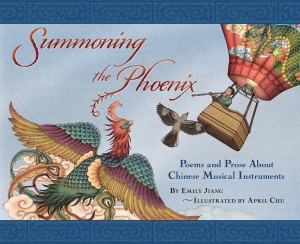
ST: Do you have any upcoming projects you might like to talk about?
My debut picture book is called Summoning the Phoenix: Poems & Prose about Chinese Musical Instruments and it is published by Shen’s Books, which the newest imprint of Lee & Low Books. Summoning the Phoenix is gorgeously illustrated by April Chu and was released in April 2014. Links to previews of poetry and art on my web site: http://www.emilyjiang.com.
If you can summon
a phoenix, feathers aflame,
you’ve played true music.
Also, I have a poem “Self-Portrait” that will be reprinted in an anthology In Other Words, edited by Saira Ali and Julia Rios. It will be a limited edition chapbook & an e-book. I’m delighted to be a part of this wonderful project in support of Con or Bust. In Other Words will be available in July 2014. Plus, “Self-Portrait” was originally published in the very first issue of Stone Telling!
Poetry gives voice
to identity and space
to navigate dreams.
ST: Thank you very much, Emily!
_____
If you enjoyed this poem and the interview, please consider letting the poet know! Also, we now have a Patreon page, and would appreciate your support.

